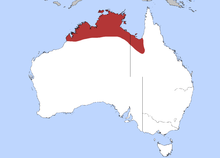Long-tailed finch
| Long-tailed finch | |
|---|---|
 |
|
| Scientific classification | |
| Kingdom: | Animalia |
| Phylum: | Chordata |
| Class: | Aves |
| Order: | Passeriformes |
| Family: | Estrildidae |
| Genus: | Poephila |
| Species: | P. acuticauda |
| Binomial name | |
|
Poephila acuticauda (Gould, 1840) |
|
 |
|
| Distribution | |
The long-tailed finch (Poephila acuticauda) is a common species of estrildid finch found in Australia; also known as the Blackheart Finch,shaft-tail finch, Heck's grassfinch, Heck's grass finch, and Heck's finch. It is a predominantly fawn-coloured bird with a pale grey head and prominent black bib and eyes. It has an estimated global extent of occurrence of 1,000,000–10,000,000 km2. It inhabits dry savannah habitats in Australia and adapts readily to aviculture. The IUCN has classified the species as being of least concern.
The long-tailed finch was first described by ornithologist John Gould in 1840 as Amadina acuticauda, having been collected by Benjamin Bynoe, the surgeon aboard HMS Beagle. It is one of three species in the genus Poephila. It is placed in the Australo-papuan finch family Estrildidae, although this family itself was previously placed in the sparrow family Passeridae.
A genetic study published in 2005 showed that the two subspecies of the long-tailed finch were separated from each other by the Kimberley Plateau–Arnhem Land Barrier around 340,000 years ago, and their ancestors diverged from the black-throated finch (P. cincta) across the Carpentarian Barrier 600 thousand years ago.
The adult long-tailed finch is around 15 cm (6 in) in length. It has a prominent roundish black bib on its throat and upper chest and a long pointed black tail. It has pinkish brown upperparts with paler plumage below its bib over the lower breast and abdomen. It has a grey head, a white ear-patch, and black lores. It has black patches on its upper flanks and its rump and undertail coverts are white. The beak colour of the adult long-tailed finch varies from red through orange to yellow. The subspecies with red beaks is sometimes called Heck's grass finch Poephila acuticauda hecki, and the nominate subspecies with orange or yellow beaks is sometimes called the long-tailed grass finch. Males and females are similar, except the females may be slightly duller and may have a slightly smaller bib. Females have shorter wings and tails than males on average, but their measurements, as well as throat bib size, generally lie within the range of male measurements. Furthermore, male and female plumage is indistinguishable in ultraviolet and visible light. A study published in 1999 showed that male long-tailed finches were unable to determine the sex of unfamiliar members of their species unless the latter bird declared its sex by song. Juveniles have black beaks and shorter tail feathers.
...
Wikipedia

